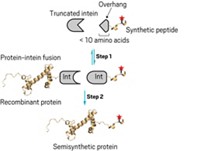Advertisement
Grab your lab coat. Let's get started
Welcome!
Welcome!
Create an account below to get 6 C&EN articles per month, receive newsletters and more - all free.
It seems this is your first time logging in online. Please enter the following information to continue.
As an ACS member you automatically get access to this site. All we need is few more details to create your reading experience.
Not you? Sign in with a different account.
Not you? Sign in with a different account.
ERROR 1
ERROR 1
ERROR 2
ERROR 2
ERROR 2
ERROR 2
ERROR 2
Password and Confirm password must match.
If you have an ACS member number, please enter it here so we can link this account to your membership. (optional)
ERROR 2
ACS values your privacy. By submitting your information, you are gaining access to C&EN and subscribing to our weekly newsletter. We use the information you provide to make your reading experience better, and we will never sell your data to third party members.
Biological Chemistry
Lab-Made Protocells Show Hints Of Evolution
Catalyst confers a selective advantage by enhancing cell mimics’ ability to grow
by Carmen Drahl
May 27, 2013
| A version of this story appeared in
Volume 91, Issue 21
“Survival of the fittest” is one of the central notions of Darwinian evolution. But how collections of molecules came to behave in a Darwinian fashion remains a mystery. Now, Katarzyna Adamala and Jack W. Szostak of Harvard University have shed light on the role catalysts may have played (Nat. Chem. 2013, DOI: 10.1038/nchem.1650). The pair enclosed a catalytic peptide inside fatty acid vesicles to make partial mimics of primitive cells. They then mixed these vesicles with vesicles lacking the catalyst and compared the vesicles’ growth. The catalyst-containing vesicles grew more efficiently, sometimes even at the expense of their neighbors. That’s because the catalyst generates a hydrophobic peptide product that makes fatty acids accumulate more efficiently in vesicle membranes. This system can’t yet evolve because the catalyst can’t be passed from one generation of cells to the next, Szostak says. In the future, however, it might be possible to achieve evolution in the lab by loading vesicles with a ribozyme catalyst that is heritable.




Join the conversation
Contact the reporter
Submit a Letter to the Editor for publication
Engage with us on Twitter